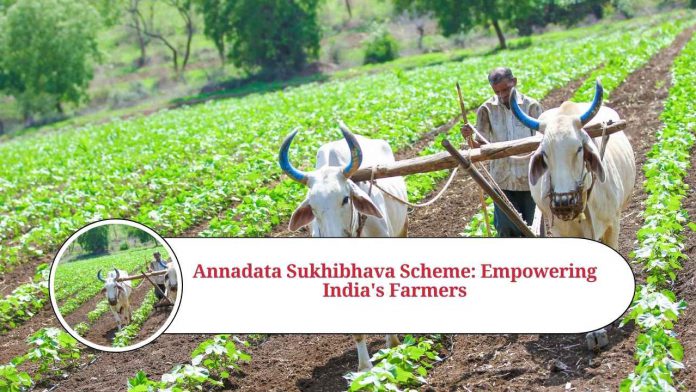Introduction:
In a country where agriculture plays a pivotal role in the economy, the welfare of farmers is crucial for overall progress. The Indian government has introduced various schemes and initiatives to uplift farmers and improve their living conditions. One such notable scheme is the Annadata Sukhibhava Scheme. This blog post delves into the key aspects of the scheme, its objectives, implementation, and its impact on the farming community.
Understanding the Annadata Sukhibhava Scheme:
- What is the Annadata Sukhibhava Scheme?
- How does it aim to benefit farmers?
- Who is eligible to avail of its benefits?
Objectives of the Scheme:
- Enhancing the financial well-being of farmers
- Reducing farmers’ debt burden
- Ensuring fair compensation for agricultural produce
- Strengthening the agricultural infrastructure
Implementation and Key Features:
- Direct Benefit Transfer (DBT) system
- Identification and registration of eligible farmers
- Verification and disbursal of funds
- Grievance redressal mechanisms
Components of the Scheme:
- Financial assistance to farmers
- Debt relief measures
- Support for crop insurance
- Infrastructure development and modernization
Benefits and Impact:
- Enhanced income and improved quality of life for farmers
- Reduction in farmer suicides
- Increased agricultural productivity and growth
- Strengthening the agricultural value chain
- Empowerment of women farmers
Challenges and Future Prospects:
- Potential challenges in implementing the scheme effectively
- Scope for improvements and further expansion
- Synergy with other agricultural reforms and schemes
Success Stories and Case Studies:
- Real-life accounts of farmers benefiting from the scheme
- Positive impact on specific regions and crops
- Empowering marginalized and small-scale farmers
Criticisms and Debates:
- Evaluation of the scheme’s effectiveness
- Financial sustainability and resource allocation
- Potential areas for refinement and enhancement
Monitoring and Evaluation:
- The importance of monitoring and evaluating the scheme’s progress
- Mechanisms in place to track the implementation and impact of the scheme
- Regular assessment and feedback from farmers and stakeholders
Lessons from International Models:
- Comparative analysis of similar schemes in other countries
- Best practices and lessons that can be applied to the Annadata Sukhibhava Scheme
- International collaboration and knowledge-sharing for agricultural development
Farmer Empowerment and Skill Development:
- Training programs and capacity-building initiatives for farmers
- Promoting sustainable farming practices and agricultural innovations
- Encouraging entrepreneurship and diversification in the agricultural sector
Promoting Organic Farming and Sustainability:
- Encouraging farmers to adopt organic farming methods
- Incentives for sustainable agriculture and conservation of natural resources
- The role of the Annadata Sukhibhava Scheme in promoting environmentally friendly practices
Collaborations with Agricultural Institutions and Organizations:
- Partnerships with research institutes and universities for knowledge dissemination
- Engaging agricultural extension services to support farmers
- Leveraging the expertise of non-governmental organizations in rural development
Future Roadmap and Policy Reforms:
- Addressing the challenges and gaps in the current agricultural system
- Reforms in land policies, market access, and crop diversification
- Synergies with other government schemes such as soil health cards and irrigation initiatives
Awareness and Outreach Campaigns:
- Spreading awareness about the Annadata Sukhibhava Scheme
- Engaging with farmers through community events and workshops
- Leveraging technology and social media platforms for effective communication
Global Recognition and Impact:
- Recognition of the Annadata Sukhibhava Scheme on the international stage
- Impact on India’s global position in agriculture and food production
- Opportunities for international collaboration and investment in the agricultural sector
Public-Private Partnerships:
- Engaging private sector players in the implementation and support of the scheme
- Encouraging investment in agri-infrastructure and value-added industries
- The role of corporate social responsibility in supporting farmers’ welfare
Empowering Women in Agriculture:
- Special provisions and incentives for women farmers under the scheme
- Promoting gender equality and women’s entrepreneurship in agriculture
- Success stories of women farmers benefiting from the Annadata Sukhibhava Scheme
Conclusion:
- The Annadata Sukhibhava Scheme as a transformative initiative for farmers
- The importance of sustained government commitment and policy reforms
- A call to action for stakeholders to support and strengthen the agricultural sector
The Annadata Sukhibhava Scheme holds immense potential to uplift India’s farmers and revolutionize the agricultural landscape. With its comprehensive approach, direct benefit transfer system, and focus on empowering farmers, the scheme aims to create a sustainable and prosperous future for the farming community. Through continuous monitoring, evaluation, and collaboration, the scheme can pave the way for a resilient and inclusive agricultural sector, ensuring the well-being of those who feed the nation.
Frequently Asked Questions (FAQs)
What is the Annadata Sukhibhava Scheme?
The Annadata Sukhibhava Scheme is a welfare initiative launched by the Indian government to support farmers and enhance their financial well-being. It provides direct financial assistance to eligible farmers and aims to reduce their debt burden while promoting agricultural growth and development.
Who is eligible to avail of the benefits under the scheme?
Farmers who own cultivable land, including small and marginal farmers, are eligible to avail of the benefits under the Annadata Sukhibhava Scheme. The scheme also extends support to tenant farmers, sharecroppers, and landless agricultural laborers.
How is the financial assistance provided to farmers?
The financial assistance is provided through a Direct Benefit Transfer (DBT) system, where the funds are transferred directly to the bank accounts of eligible farmers. The amount is disbursed in installments and varies based on factors such as landholding size and cropping pattern.
What are the objectives of the scheme?
The primary objectives of the Annadata Sukhibhava Scheme include enhancing the financial well-being of farmers, reducing their debt burden, ensuring fair compensation for agricultural produce, and strengthening the agricultural infrastructure.
Is the scheme limited to a specific region or crop?
No, the Annadata Sukhibhava Scheme is applicable across India and covers various crops. It aims to benefit farmers engaged in diverse agricultural activities, ensuring inclusivity and support for farmers across different regions and crop types.
Are there any debt relief measures under the scheme?
Yes, the scheme includes debt relief measures to reduce the financial burden on farmers. It provides assistance in the form of loan waivers and interest subvention to help farmers manage their debts effectively.
Is crop insurance support available under the scheme?
Yes, the Annadata Sukhibhava Scheme provides support for crop insurance to protect farmers against crop failures, natural disasters, and other unforeseen events. This component aims to mitigate the risks associated with farming and provide financial security to farmers.
How does the scheme contribute to infrastructure development in agriculture?
The scheme allocates funds for the development and modernization of agricultural infrastructure, including irrigation systems, farm mechanization, storage facilities, and market infrastructure. These initiatives aim to improve productivity, reduce post-harvest losses, and enhance the overall efficiency of the agricultural value chain.
What measures are in place to address grievances and ensure transparency?
The scheme has established grievance redressal mechanisms to address any issues or concerns faced by farmers. Dedicated helpline numbers, online portals, and local administrative channels are set up to facilitate the resolution of grievances. Additionally, transparency is maintained through robust verification processes and audits.
What has been the impact of the Annadata Sukhibhava Scheme?
The scheme has had a positive impact on farmers’ lives by enhancing their income and improving their quality of life. It has contributed to reducing farmer suicides, increasing agricultural productivity, and strengthening the agricultural value chain. Furthermore, the scheme has empowered women farmers and brought about positive changes in specific regions and crops.




















